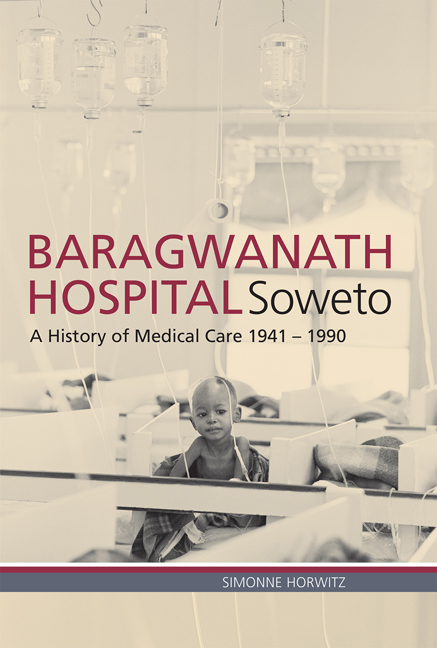Book contents
- Frontmatter
- Contents
- Acknowledgements
- List of Illustrations
- List of Abbreviations
- A note on terminology
- 1 Introduction: A Hospital in Soweto
- 2 From Allied Military Hospital to Urban African Hospital
- 3 Apartheid and Administration: The Hospital, Provincial Administration and the University of the Witwatersrand
- 4 Missionaries, Clinicians, Activists and Bara Boeties: The Doctors of Baragwanath Hospital
- 5 Black Nurses in White: The Nurses of Baragwanath Hospital
- 6 Chronic contradictions: The struggle of Baragwanath in the 1980s
- 7 Baragwanath's Transition and Legacy
- Bibliography
- Index
- Plate Section
2 - From Allied Military Hospital to Urban African Hospital
Published online by Cambridge University Press: 20 April 2018
- Frontmatter
- Contents
- Acknowledgements
- List of Illustrations
- List of Abbreviations
- A note on terminology
- 1 Introduction: A Hospital in Soweto
- 2 From Allied Military Hospital to Urban African Hospital
- 3 Apartheid and Administration: The Hospital, Provincial Administration and the University of the Witwatersrand
- 4 Missionaries, Clinicians, Activists and Bara Boeties: The Doctors of Baragwanath Hospital
- 5 Black Nurses in White: The Nurses of Baragwanath Hospital
- 6 Chronic contradictions: The struggle of Baragwanath in the 1980s
- 7 Baragwanath's Transition and Legacy
- Bibliography
- Index
- Plate Section
Summary
What was new and exciting about this convoy [of ambulances and buses] on May 1st 1948 was that it was conveying non-European patients to their own hospital on its opening day, and for them this was a move from grossly overcrowded conditions at the Non-European Hospital in Johannesburg to a place of quietness and light and, above all, a place where each patient had a bed to sleep on and space to move about freely.
The ‘place of quietness and light’ was Baragwanath Hospital. Ironically, within a few years of its opening the hospital became so overcrowded that few patients had a bed to themselves and there was very little ‘space to move about freely’. Yet the early excitement about the opening of Baragwanath as a civilian hospital for black patients should be seen in the wider context. From the early debates about the establishment of Baragwanath as an Allied military hospital in the early 1940s to its subsequent acquisition by the Transvaal Provincial Administration (TPA), Baragwanath's history was deeply intertwined with arguments about the provision of urban African health care. The story of the birth and death of Baragwanath's first phoenix and its place within the context of urban African health care is important in itself. But the early years also saw the foundation of a specific Baragwanath ethos, for the staff in the early years were those who practised medicine in difficult under-resourced situations – military or civil – and thrived. They developed innovative solutions that they were proud of, and they often stressed the mutual support and assistance created by working in such conditions.
Soweto and its health services, pre-1948
The area today known as Soweto was given its name in 1963 – a composite, coined from the first two letters of each of the words South Western Township. The first of the sub-townships or suburbs was formed in 1905 when the Johannesburg City Council used an outbreak of bubonic plague as a stimulus to clear a Johannesburg slum where Africans and Indians had been living. Over one thousand Africans were moved to Klipspruit. At the same time it became illegal for Africans to live in the city unless they were living in compounds at one of the mines, or working as live-in domestic workers in homes in the white suburbs.
- Type
- Chapter
- Information
- Baragwanath Hospital, SowetoA history of medical care 1941–1990, pp. 27 - 55Publisher: Wits University PressPrint publication year: 2013

